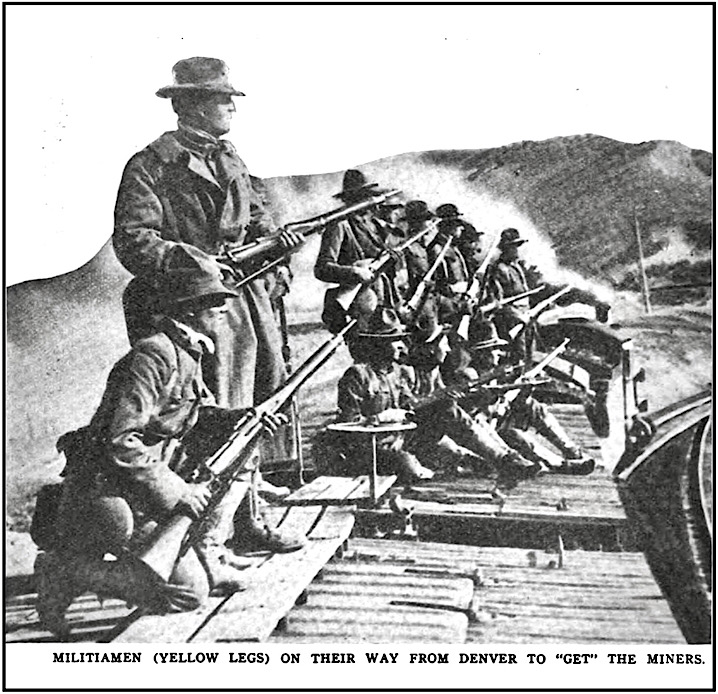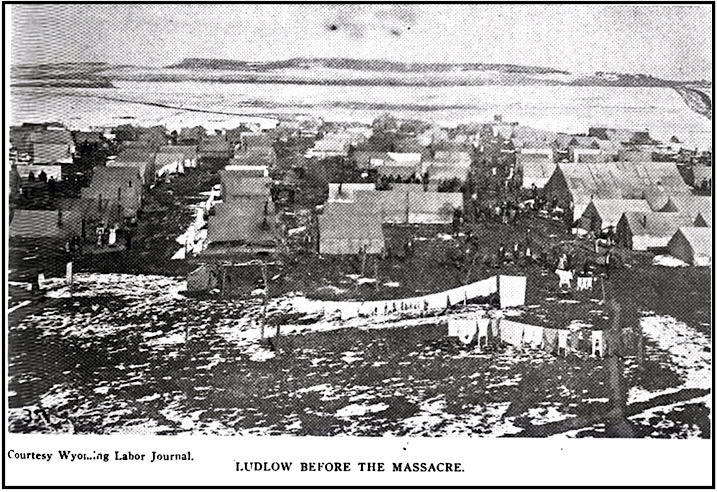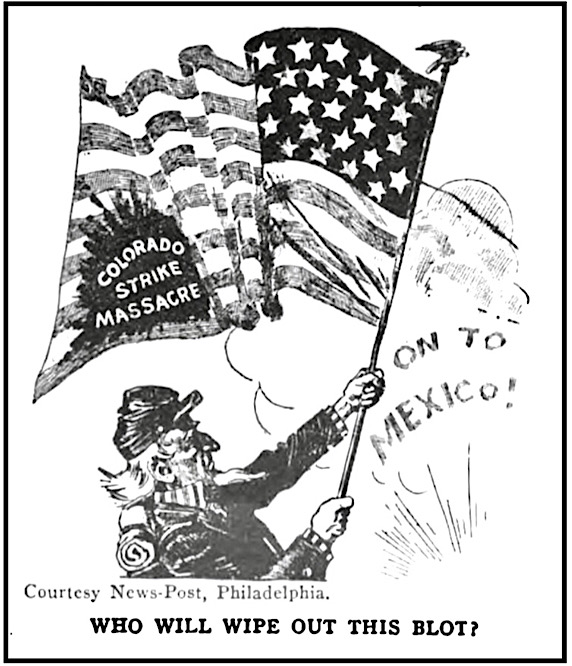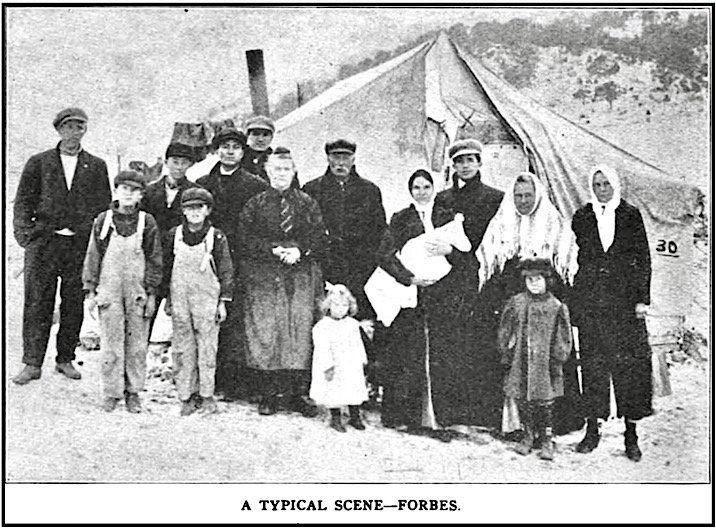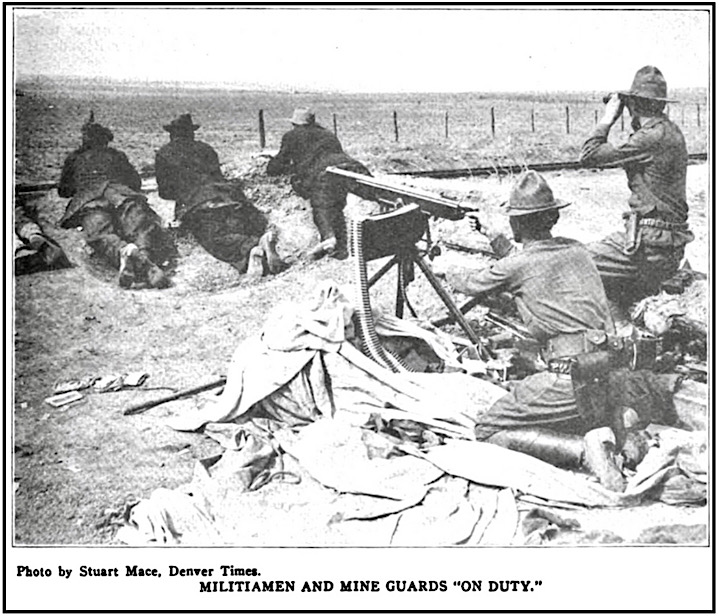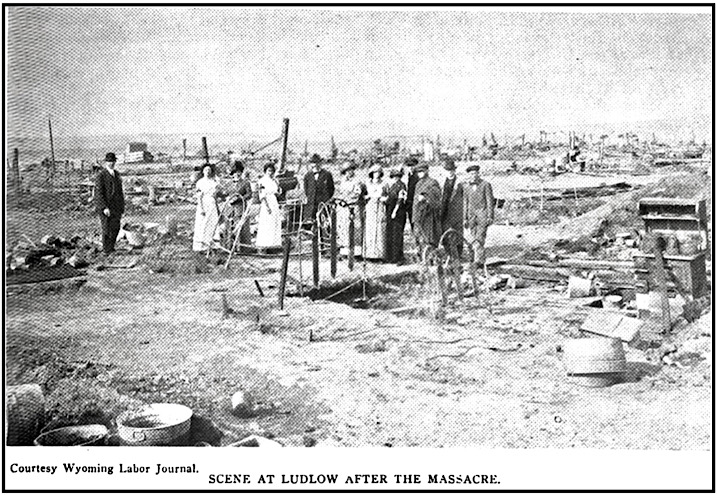 —————
—————
Hellraisers Journal – Tuesday June 2, 1914
“The Class War in Colorado” by Leslie H. Marcy, Part I
From the International Socialist Review of June 1914:
THE CLASS WAR IN COLORADO
By Leslie H. Marcy
“SOCIETY AS A WHOLE IS MORE AND MORE SPLITTING UP INTO TWO
HOSTILE CAMPS, INTO TWO GREAT CLASSES DIRECTLY FACING EACH
OTHER: THE CAPITALIST CLASS AND THE WORKING CLASS.”[Part I of II]
FOR thirty years an industrial warfare has been going on in Colorado between the coal miners and the coal owners. In fact, in every state and country where coal is mined we find an irrepressible conflict of interests. Temporary truces are signed from time to time in the way of contracts mostly CON so far as the men are concerned-and again, there is open warfare as witnessed recently in England, West Virginia and South Africa.
Time was when the coal miners of this country worked 16 hours a day, but, by combining their strength into unions they have cut the hours of their slavery to eight and improved their working conditions. No wonder that their battle cry is “The Union Forever”! No wonder that the Coal Barons cry out for the standing army to protect them when all else has failed!.
The Battle of Ludlow was inevitable. For seven months the southern coal fields of Colorado have been divided into two hostile camps: the Owners organized into the Operators Association; the Workers organized in unions of the United Mine Workers of America, with interests diametrically opposed.
The main issue is the right of the miners to organize. The Colorado Statutes are very clear on this subject and the miners have the legal right of way, but, the “law is a dead letter in the section of Colorado 100 miles square,” or wherever the Operators own the land.
On September 23, 1913, the union miners went on strike to enforce their constitutional rights: to organize; to work an 8-hour day, to semi-monthly pay, to have their own Check-weighman, to trade where they pleased,-ALL OF WHICH WERE DEAD LAWS. Each proposition related to a law that was being violated. The whole proposal simmered down to a single statement is this: “If you coal diggers will give up your union, the operators promise to obey the state laws which have been passed for your protection.”
Now the Coal Capitalists not only owned the land and the coal, as far down as hell, but they also owned the churches, schools, saloons and shacks or twentieth century cabins, where the miners were allowed to live, at so much per month. The first move on the Operators’ part was to break up these free American homes. “Get off, swim into the lake, fly into the air, go anywhere, but get off”-our property! And the law was strictly enforced.
The merciless economic hold of the coal companies was clearly brought out in the Congressional investigation from which we quote as follows:
The Chairman-Let me tell you this and see what you think about it. In some of the camps out there, it is so testified to-and I think some in which your company is interested-a town is incorporated, and all the property there is owned by your company, with a sign up, “Private Property.” These incorporated mining towns elect a mayor, who is usually the mine superintendent or some one connected with the mine. They conduct the business of the town, levying a poll tax of $1.50 on the miners, and with the saloon licenses are able to conduct the town and pay the expenses. Have you ever looked into that to find out whether or not that is a fact?
Mr. Rockefeller-No: I have no knowledge of that. I should think it would be quite necessary and proper that when a company bought a mine it should buy property in the vicinity of the mine to provide for the workers who must inevitably be there to work the mine. I should think that that was a wise policy, to buy lands in the vicinity-
The Chairman-All around the mine?
Mr. Rockefeller-So as to concentrate conveniently the residences of the employes.
The Chairman-And then these people living in this town-the miners, those who work for the companies-are compelled to rent your property?
Mr. Rockefeller-You say “compelled”-
The Chairman- Yes, “compelled,” if they work for your company.
Mr. Rockefeller-They are not compelled to work for the company.
Land was immediately leased and tent colonies were established by the U. M. W. A. Everything possible was done to barricade the men, women and children against the bitter cold of the coming winter. At Ludlow 400 tents covered nearly 1,000 people, including 271 children, twenty-one babies having been born there since October.
The great majority of the strikers do not speak English. For the most part they are strike-breakers who were brought into Colorado during the bitter struggle of ten years ago, and have themselves become unionized. Twenty-one nationalities are represented, Greeks and Italians making up the largest number.
The Ludlow Colony, 18 miles north of Trinidad on the direct road to Walsenberg [Walsenburg], was a strategic position for the miners, as it enabled them to picket the station of the Colorado Southern Railroad at Ludlow where strike-breakers detrained for several of the largest mines.
The Colorado Fuel and Iron Company operate in this district and they lost no time in shipping in professional strikebreakers and gunmen, as well as Japs and Negroes to work in the mines. The Baldwin-Felz [Felts] detective agency sent in their most expert man-killers, altho Section 3 of the state laws of Colorado on Labor Disputes reads-“Any person or persons who shall hire, aid, abet, or assist in hiring, through agencies or otherwise, persons to guard with arms or deadly weapons of any kind, other person or property in this State, or any person who shall come into this State armed with deadly weapons of any kind for any such purpose, without a permit in writing from the Governor of this State, shall be guilty of a felony.
Many of these gunmen had “operated” in the coal strike in West Virginia and the copper strike in Michigan and it is unnecessary perhaps to remind our readers that these men are hired to “start something.” They immediately got busy on the job. There was trouble every day for the strikers, which gave the operators a chance to hire the state militia under the pretext of preserving-“law and order,” but in reality to help break the strike.
Early in December “at the suggestion of Governor Ammons, a committee of five was appointed by John R. McLennon [McLennan] of the State Federation of Labor to investigate charges made against the militia in the Denver convention of the Federation. This committee was a representative one. James H. Brewster who wrote the report, was for years professor of law at the University of Michigan, an impartial citizen who had gone to Colorado for his health.
“The governor empowered the committee to fully investigate conditions and take testimony. The stenographic records of 163 witnesses filled 760 typewritten pages. The testimony made a red hot union man of Mr. Brewster and he consented to conduct the case of the unions before the Congressional Investigating Committee.
“In their report the five men on the committee unanimously agreed that Lieut. E. K. [K. E.] Linderfelt, who was in charge of the militia quartered near Ludlow, was doing all in his power to provoke the strikers to violence. It seemed to the committee that he was especially anxious to get Louis Tikas into trouble. Once he arrested him for some trivial offence and held him without lodging a charge against him. The report reads:
“We have reason to believe that it is his (Linderfelt’s) deliberate purpose to provoke the strikers to bloodshed. Every decent member of the militia who knows Louis Tikas will testify that he is an admirable man for the place he fills; that he is fair, and that he will assist the militia in every proper way in policing the neighborhood, yet it is this man whom Linderfelt tries to provoke in order that some other members of the colony will be aroused out of sympathy, and it is this man whom Linderfelt is reported to have threatened to kill on the slightest provocation.”
It was not long before the majority of the gunmen were wearing militia uniforms, which further complicated matters, as the majority of the militia were in sympathy with the coal miners. Many of them visited Mother Jones during her six months illegal imprisonment and they told her that never again would they wear the uniform. It also develops that 584 deputies were sworn in as far back as August and yet no salaries had been demanded from the state. They were on the pay-roll of the owners of the state-the Coal Operators’ Association.
As the weeks and months passed by, the Operators became desperate. The strike was costing them thousands of dollars a week. The pay-roll of the militia officers alone amounted to $28,943.07 a month. Every politician in the state lined up at the pie-counter and got on the pay-roll. The state auditor’s report shows that there were 397 officers and 695 privates. There were generals, majors, colonels and captains drawing salaries up to $400 a month and expenses. The privates were drawing $1.00 per day and expenses from the state besides the $3.00 a day which many of them drew from the coal companies. Add to this the wages of deputies and gunmen and you can readily figure out why the operators were worried.
The state ran so far in debt that the militia had to be withdrawn. The ranks of the strikers remained unbroken. Something had to be done to break the strike and the gunmen got busy. Troop A was organized by Lieut. K. E. Linderfelt a Baldwin-Felz gunman. Of the 126 men, 90 per cent were employes (?) of the coal corporation. Company B was composed of gunmen and mine guards under the command of Major Hamrock. None of the company had a permanent occupation sufficiently important to warrant his return to Denver when the general order for the recall of the militia was issued. There were 36 thugs all told. Their names are kept secret.
That the battle of Ludlow was deliberately planned is proven beyond all reasonable doubt by affidavits of the miners as well as by the report of the military probe committee which conducted an investigation after the massacre. This committee was composed of Major Edward J. Boughton, Captain W. C. Danks and Captain Philip Van Cife [Cise], of the Colorado National Guard and their report recommended the court martial of every officer and enlisted man of the state militia who participated in the burning of Ludlow colony.
The following affidavit speaks for itself:
State of Colorado, County of Las Animas, ss.
Frank Didano, being first duly sworn, upon oath deposes and says:
That his name is Frank Didano; that on Monday, April 20, he was playing baseball in the grounds back of the Snodgrass store with one Tom Romeo. He heard some explosion about 9 a. m., and saw five or six men and some women running from the depot at Ludlow, to the tent colony. He looked over and saw some soldiers near the steel bridge and some more near the soldiers’ tents dragging out a machine gun. He heard some more explosions and started to run with his companion to the tent colony. The machine guns opened fire on the tent colony at once, and affiant ran for his life to the arroya. Frank Rubino ran with the affiant and was struck by an explosive bullet and killed.
Affiant hid in the arroya until about 4:30,and then ran away. Affiant saw the train from Trinidad bring more machine guns and guards. The firing of the machine guns was awful; they fired thousands and thousands of shots.
Affiant had no gun. There were a very few guns in the tent colony. Affiant does not think there were more than fifty, including shotguns and all. Affiant’s tent, No. 18, had a big American flag on it, and an Italian flag underneath the American flag. At least forty or fifty tents in the tent colony had American flags and flags of all nations on them. In all cases the American flag was on the poles above the other flags.
Many women and children were in the tents, but were afraid to crawl out of the shallow pits under the tents, and several men were killed trying to get to them. They put a machine gun on top of a hill and commenced shooting down into the arroya where affiant was hidden, together with some other people-women and children-and affiant ran away and came to Trinidad. The soldiers and mine guards tried to kill everybody; anything they saw move, even a dog, they shot at.
FRANK DIDANO.
Subscribed in my presence and sworn to before me
this 23rd day of April, A. D. 1914.
My commission expires on the 18th day of July, A. D. 1915.
ANGUS E. McGLASHAN,
(Seal) Notary Public.[Report of Military Probe Committee]
Excerpts from the official report of the military committee are as follows:
“We find that the remote cause of this, as of all other battles, lies with the coal operators who established in an American industrial community a numerous class of ignorant, lawless and savage South-European peasants. The present underlying cause was the presence near Ludlow, in daily contact one with another, of three discordant elements-strikers, soldiers and mine guards, all armed and fostering an increasing deadly hatred which sooner or later was bound to find some such expression.”
The battle was precipitated by the firing of two crude bombs by order of Major Hamrock, “and, so far as we can learn, this was the first explosion of the day. We learned from the colonists that they were thought to be some new kind of ammunition, or possibly artillery possessed by the soldiers.”
“The Greeks were vociferous and insistent upon giving battle to the soldiers at once if they should appear. Tikas did the best he could to dissuade and quiet them.”
“Lieutenant Lawrence, having reported to the major, left to return to his detachment on Water Tank hill. He had gone but a short way when he galloped back to the station and cried out: ‘My God, Major, look at those men; we are in for it,’ pointing toward the Greeks defiling toward the railroad cut. Tikas was the first to answer.
“He immediately jumped up, saying ‘I will stop them,’ and, pulling out his handkerchief, ran toward the colony, waving to the Greeks to return. A civilian and union sympathizer who met Tikas as he ran, told us that he heard him exclaim: ‘What damned fools!’
“Major Hamrock directed Lieutenant Lawrence to return to his troop and await developments. After the lieutenant reached Water Tank hill, and not before, the machine gun and remaining men from Cedar hill arrived. Major Hamrock hurried from the station to his tents, and reported the conditions to General Chase in Denver.
“While returning to his camp the major observed the women and children of the colony in large numbers running from the colony north to the shelter of the arroya.
“Lieutenant Benedict, observing the colony at this time through his field glasses, plainly saw Tikas leave and hurry toward the Greeks, now nearly arrived at their intended position. Tikas was carrying a rifle in one hand and a field glass in the other. It is evident that on returning to the colony and seeing the futility of preventing the outbreak, Tikas had armed himself and hastened to his compatriots.
“Shortly after the firing commenced it became very general. On the strikers’ side it proceeded from the railroad cut, from the tent colony and from the arroya beyond it. It was returned from Water Tank hill, from a row of steel cars in the vicinity of the soldiers’ tents, and from houses and stores along the road between the colony and the northern canyon. Lieutenant Lawrence and three men advanced from Water Tank hill toward the Greek position in the railroad cut, with a view to dislodge the men shooting from that cover.
“One of these men, Private Martin, was shot through the neck.
“They were compelled to leave Martin under cover and return without him. As they retreated the strikers followed until under cover. Several attempts were made by the soldiers during the day to recover their wounded comrade, but it was not until the afternoon, when Captain Carson arrived from Trinidad with reinforcements and another machine gun, that they were able to drive the strikers back and reach the place where Martin lay.”
As the conflict became more deadly the two machine guns pumping 400 soft-nosed bullets a minute were turned on the tents.
“It was then that Major Hamrock tested his range with the machine guns on Water Tank hill and sent them directly into the first tents of the colony itself, at the same time the strikers’ fire drew a return from all combatants into the same tents. It was this concentrated fire upon the nearest tents in the southwest corner of the colony that set them on fire.”
“As one tent caught after another, several other explosions occurred. During this time some of the men, having nearly reached the tent colony, heard the screams of women and called to men whom they saw firing from between the tents to get their women out.
“The only answer were the words, ‘You go to hell,’ spoken with a foreign accent, and accompanied by a rain of shots.”
For fourteen hours the battle raged. The list of killed and wounded will never be known but the fact that the regular army was sent to preserve “law and order” shows that the gunmen got all the lead they wanted.
“During the rescuing and afterwards, the tent colony was invaded by the soldiers and mine guards for quite a different purpose. By this time the uniformed guardsmen had been joined by large numbers of men in civilian attire, part of whom were from Troop “A” and part of them mine guards, all unknown to the uniformed soldiers and their officers and all unused and unamenable to discipline.
“By this time, the time of the burning of the tents, the nondescript number of men had passed out of their officers’ control, had ceased to be an army and had become a mob. Doubtless all were seeing red on both sides of the conflict.
“We find that the tents were not all of them destroyed by accidental fire. Men and soldiers swarmed into the colony and deliberately assisted the conflagration of spreading the fire from tent to tent.
“Beyond a doubt, it was seen to intentionally that the fire should destroy the whole of the colony. This, too, was accompanied by the usual loot.
“Men and soldiers seized and took from the tents whatever appealed to their fancy of the moment. In this way, clothes, bedding, articles of jewelry, bicycles, tools and utensils were taken from the tents and conveyed away.
“So deliberate was this burning and looting that we find that cans of oil found in the tents were poured upon them and the tents lit with matches.”
-Report of Military Probe Committee.
[Emphasis added.]
~~~~~~~~~~~~~~~~~~~~~~~~~
SOURCES & IMAGES
Quote John Lawson 1913, shortly after October 17th Death Special
attack on Forbes Tent Colony, Beshoar p74
https://archive.org/details/outofdepths0000unse/page/74/mode/1up?q=bandanna
International Socialist Review
(Chicago, Illinois)
-June 1914, begins on page 708
https://www.marxists.org/history/usa/pubs/isr/v14n12-jun-1914-ISR-gog-ocr.pdf
See also:
Communist Manifesto, Marx/Engels, 1848
“Society as a whole….
https://www.marxists.org/archive/marx/works/1848/communist-manifesto/ch01.htm
Ludlow, being the report of the Special Board of Officers appointed by the Governor of Colorado to investigate and determine the facts with reference to the armed conflict between the Colorado National Guard and certain persons engaged at the coal mining strike at Ludlow, Colo., April 20, 1914
-by Colorado. Special Board of Officers to Inquire into the Armed Conflict, April 20, 1914
Denver CO, 1914
https://archive.org/details/ludlowbeingrepor00colorich/page/19/mode/1up?q=tikas
Biennial Report
Colorado. Bureau of Labor Statistics, 1914
(search: didano)
https://books.google.com/books?id=1q0XAQAAIAAJ
Hellraisers Journal – Thursday November 6, 1913
From the Denver United Labor Bulletin of November 1, 1913:
Southern Colorado Coalfields – State Militia Arrives, Strikers Standing Firm; Captain Van Cise Issues “Shoot to Kill” Orders
Hellraisers Journal – Saturday January 3, 1914
Trinidad, Colorado – State Federation of Labor Committee Begins Investigation
Hellraisers Journal – Saturday April 11, 1914
Washington, D. C. – John D. Rockefeller Jr. Testifies Before Federal Investigators
Hellraisers Journal – Monday June 1, 1914
John Sloan Illustrates the Ludlow Massacre for The Masses
Tag: Ludlow Massacre
https://weneverforget.org/tag/ludlow-massacre/
Tag: Colorado Coalfield War of 1914
https://weneverforget.org/tag/colorado-coalfield-war-of-1914/
Tag: Colorado Coalfield Strike of 1913-1914
https://weneverforget.org/tag/colorado-coalfield-strike-of-1913-1914/
~~~~~~~~~~~~~~~~~~~~~~~~~
«Colorado Strike Song» (Το τραγούδι της Απεργίας του Κολοράντο)


